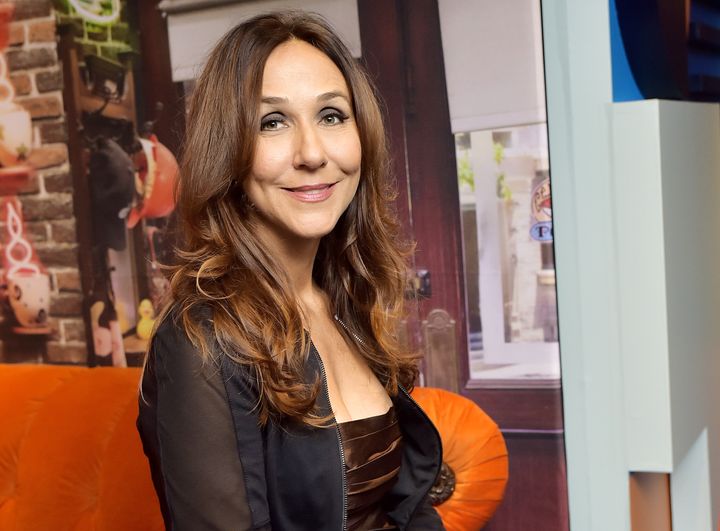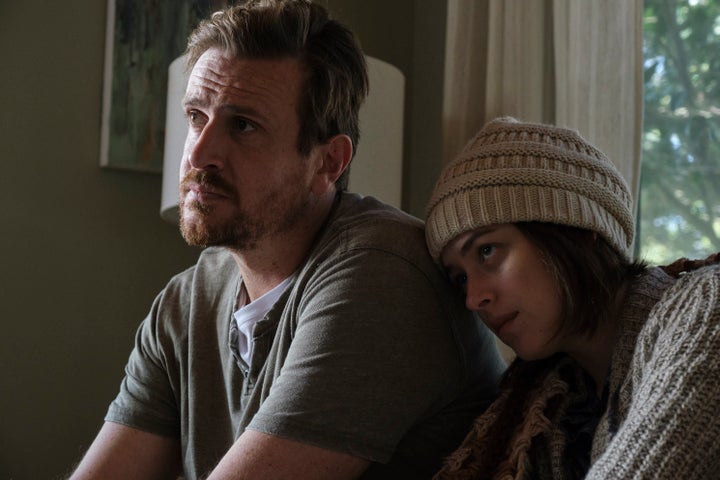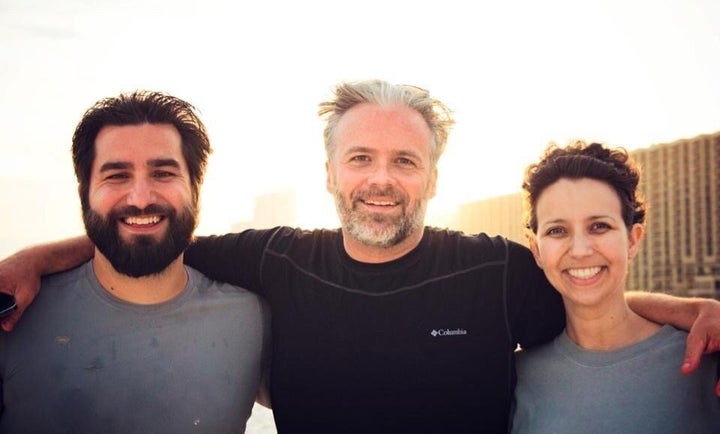
Gabriela Cowperthwaite rattled viewers with her 2013 documentary “Blackfish,” in which she explored killer whale captivity and the controversial sea park industry. The film sparked an activist movement, and in 2016, SeaWorld announced it would end its breeding program and orca shows at all of its theme parks.
“The fact that a multi-billion dollar corporation may lend massive resources to conservation, to the discussion of what it means to be ‘humane,’ to protecting our oceans etc. could be a tremendous game changer,” Cowperthwaite told HuffPost at the time.
As a filmmaker, Cowperthwaite’s goal is to spark change and bring authentic stories to life. That’s why, shortly after the success of “Blackfish,” she was given the opportunity to take on narrative films as an outlet to tell real-life stories.
“Reality is my touchstone, my tool set,” Cowperthwaite told HuffPost earlier this month. “When I made ‘Blackfish,’ I wanted it to feel like a narrative thriller. I didn’t want it to feel like a documentary, or pedantic, or like medicine. And so I think that must have resonated, because agents and managers called up [to pitch features].”
She received solid reviews for her 2017 narrative debut “Megan Leavey,” about a young Marine corporal (Kate Mara) and her military combat dog who saved many lives during their deployment in Iraq. Soon enough, she was offered “Our Friend,” a script based on an award-winning 2015 Esquire article by Matthew Teague that details his wife Nicole’s battle with cancer and honors their best friend, Dane Faucheux, who made the grieving experience more bearable.
“Our Friend,” now in theaters and on demand, came to Cowperthwaite at a fateful moment, when she herself was struggling to come to terms with the loss of a loved one. With the help of actors Casey Affleck, Dakota Johnson and Jason Segel, she tells a personal story of grief and friendship, and proves her chops as a filmmaker of all trades.
In this interview, Cowperthwaite talks about “Our Friend,” “Blackfish” and the long-awaited elevation of female directors.

In general, there are so many hoops and things you have to jump through as a filmmaker, and then add on top of that a pandemic.
It’s so confusing, but we know what the demand is. You understand that people are holed up and want to watch stuff, and you’re like, “I promise we’re trying to get stuff to you.” We’re gonna just figure out how many masks we have to wear and what to do. But we promise we’re out there trying to meet that demand. It’s just so weird that those two worlds are so far apart right now.
Yeah, and it’s weird because a lot of people are staying home, but expecting creators to go out there and make content for us to watch.
Right. And then there are the small films and things that take place in a cabin with two people that were shelved forever, that are now like the “hot” product, you know? So you’re like, “Yay for little independent films!”
Revisit some of those shelved scripts and get them produced!
Totally, totally. Man alone ... in a cabin.
“Our Friend” debuted in 2019 at the Toronto Film Festival, but is just now being released. Did the pandemic have anything to do with that? Figuring out when you could or should release it without the full support of movie theaters?
It was supposed to be a theatrical release. That’s what the distributors signed on for. And so there was just this lull, I remember, where we were hearing every week that there was a new plan. Like, “OK, we’re gonna go for it. OK, we’re only going to open in this many theaters. OK, we’re just going to wait and see, like, if there’s another spike.” It was really [the] blind leading the blind.
I was looking for answers, because I’m not a distributor, and I don’t really get in that game or know much about it, and everybody who would have had the answers before were just as confused as I was. And so we just pivoted hard in 2020 and said, “This is going to do great on VOD [video on demand], in a different format.” People will lock in and hole up and want to feel warmth and love and talk about the themes of friendship in a crazy, kind of crass time.
This film touches on the pain of loss and grief ― a lot of what we’ve all been dealing with over the last year or so. Are those the themes that initially drew you to the project?
Yeah. To me, it was just such a beautiful and sort of eye-opening way to look at grief. The way I saw it was, we weren’t focused directly on the disease in question and what that means to that person. We were looking at the friend, who, right when the bottom drops out from your life and you’re going to fall, someone’s sort of throwing a pillow there to cushion it. It was shifting the perspective from the pure appearance of the grief to the anchor ― the person that’s anchoring you and making sure you don’t fall too far.
Absolutely, and you get that sense from Matt’s article. I’m curious if you had read his piece ahead of time or after being pitched the project?
I read it, so I think that’s why I got the film, actually. I read it when it won the National Magazine Award and, you know, my jaw dropped to the floor. It just felt real and uncomfortable and beautiful, and I just thought it was a piece that I couldn’t shake. I never post things on social media, but I posted [the article] and sort of said, “There are stories and then there are stories. This is a tough one, but get through it. It’s beautiful.” Then a couple years later, I got the script submitted for my consideration and I looked at the log line and I was like, “Oh my gosh, no. I already love this.” And I sent a screenshot of my post, just to make sure that when I met with Matt Teague, he knew I was a believer way before this was a movie, and that I was not blowing hot air.
Sometimes those fate-like moments strike you, or there’s some sort of connection that comes full circle.
Yeah, exactly. So what spoke to me was that I had lost a best friend really, really suddenly. My grief and pain around that incident had to do with me not being able to say goodbye, and all the things I wished I had said. And it’s so weird, because then, from that moment on, I’m the person who talks like almost uncomfortably deeply and tells people, like, how much I love them. Since that moment, I was like, “Wow, you never know if that’s going to be your last conversation with somebody.” So I sort of overshare my love, only because I never want that feeling again.
Then reading about Matt and Nicole, and imagining what it would be like to say goodbye every day to somebody for three years ― it was sort of like coming at grief in this different way that helped me, I guess, look at it in a new perspective, and realize that even when you do get to say goodbye, it still throttles you. It maybe made grief seem more universal. Loss is not fair for anybody.
There’s never enough time.
I guess that’s right, there’s never enough time. And we’re all experiencing it in just this myriad of ways. But how amazing is it to have friends to get you through it, you know?

Did you work with Brad Ingelsby, who wrote the screenplay, and Matt to take that article and make sure it had all the components of a good movie?
The script had already been written by Brad, but I got my director’s pass with him, so we were all really heavily involved with each other. Brad and I went down fairly early and met both Dane and Matt and hung out in Fairhope [Alabama] with them. And meeting Dane was incredible, because I started to understand what it means to have a bunch of people upholding somebody’s memory, rather than just one. Dane can remember Nicole as a friend, her girls remember her as a mom, other people in Fairhope remember her as a musical theater actress ― it doesn’t have to rest solely on Matt to uphold the totality of one person.
So tell me about casting. Did you have actors in mind?
I knew I wanted Jason. Gosh, just what he does on screen is so unique. He obviously understands comedy probably better than anybody, but, for me, it’s this reservoir of emotion and sometimes darkness, sometimes even pain, that I can see in his eyes. When I saw him in “The End of the Tour,” that sealed it for me. The idea that the same person did that and “Forgetting Sarah Marshall,” just, Jason can just go back and forth so seamlessly.
And Dakota is similar to Jason. She can hit the entire spectrum. I think she’s one of the funniest actors out there that I know. And then she has these bright blue eyes and behind them such a vulnerability, as if she’s someone who’s fighting to be strong and might break. That felt like Nicole to me.
Then, of course, you have Casey Affleck, who won an Oscar for “Manchester by the Sea,” in which he fully captured the effects of loss and grief.
Yeah, he really does have this ability to make himself so vulnerable and so accessible. There’s just so many things about Casey that you really just see so clearly on screen. He was just emotionally available. A lot of times you imagine a dad or an actor in that role fighting his tears, you know? But there’s something about Casey ― he welcomes it. He welcomes the grief and he feels it with his whole body, and just watching that, to me, is magical.
Directing actors is probably still a new-ish journey for you, in that you’re a documentarian who made the switch to narrative films. What made you want to take that leap?
I just never had to ask permission to make a documentary, and I wanted to make film. I didn’t go to film school, I didn’t really know anybody [in the business], I didn’t grow up in L.A., like, none of that stuff. So I didn’t have an access point, really. But it was always a dream to make a feature, as well as do documentaries.
So, I was actually approached by an agent who liked “Blackfish” and then got the “Megan Leavey” script shortly thereafter. I think because Megan Leavey is a real human being, people resonated with the fact that I come from real-life stories. Then I got “Our Friend.”
Documentaries take shape as you get footage and piece things together. So is it tricky for you to work within the confines of a script? Do you allow improv or just let a scene breathe a little bit?
Oh my gosh, totally. To me, I haven’t succeeded if it doesn’t feel real. So yes, I do. For me, it’s really agility as a director and being poised to jump into making a fresh decision because I’m seeing something beautiful from an actor or I’m seeing a found moment. I have to be agile and redirect the script on the day, in the moment, and that comes from documentary. I always say I’m very comfortable with the future being a question mark. The script is best when it’s a guardrail, but I’d like to allow people the freedom to try new stuff, because that’s where so much of the magic is found. Letting real life take its course.
I noticed that you had a special credit on “Finding Dory.” Did you dip into animation, as well?
Yeah, me and Pixar! [laughs] No, that was interesting because there was a while where I couldn’t talk about that. But they showed “Blackfish” at Pixar and invited me to come and speak about the film. So I’m there at Pixar, I got to give my kids a tour, and then I’m talking to the employees and they were really quiet, kind of subdued, and asking really pointed questions about killer whales and everything. Then after the screening, a producer on “Finding Dory” came up to me and said, “We need to talk. Can you stick around, and can we show ‘Blackfish’ to [executive producer] John Lasseter? Because we’re in trouble.”
Basically, “Finding Dory” had a killer whale in captivity who couldn’t be happier. But given what they learned from “Blackfish,” they couldn’t do the movie the way they wanted to. So they said, “If you come up and we talk extensively about this, you have to sign an NDA” ― but I don’t think I ever had to. They just kind of kept it under wraps or whatever. And, essentially, I brought up the idea of a seaside sanctuary, which is a more sustainable and humane way to retire animals to their original habitat while being able to feed them and all that stuff. So I said, “That’s a way you could still have a killer whale interacting with humans, if that’s what you need for ‘Finding Dory.’” And I think that’s what it ended up being in the film?
Yeah, they had a Marine Life Institute. Look at you, you helped shape the whole thing!
I don’t really think it changed the story very much, but maybe just added that one progressive element and something that zoos and marine parks should be thinking about. They totally didn’t have to give me a credit on that, it was so sweet that they did. Very, very cool.
Before I let you go, I do want to talk about all the female directors out there doing incredible work. This year alone you have films from Chloé Zhao, Natalie Erika James, Kitty Green, Eliza Hittman, Kelly Reichardt, Radha Blank, Heidi Ewing ― just an amazing roster. How does it feel to actually see women succeed in an industry that’s slowly becoming a more equitable place?
It’s such an amazing turn of events that was a long time coming. Personally, I’ve noticed that considering me to direct something has become more of a serious conversation and less of a formality. I remember those early-on meetings, where you just sort of felt that people had to check off a box or something, and now you’re really considered for your ideas and your thoughts and your vision. And so that’s been amazing.
It’s just been transformative. It’s changed my life. I’m seeing more scripts, I feel like I’m in the game and I think, most of all, I feel listened to. I just saw “Nomadland” and was like, “Just think if we didn’t have that voice?” I think about what Chloé did with “The Rider” and “Nomadland,” and how she made people look at the working class and the economy and human beings and van life. She just gave us a portal of entry into a world, and just imagine how many more stories there are like that now.
And told from a Chinese woman’s perspective.
Exactly. Suddenly, there are just more stories, more perspective to those stories, and more things out there that people can relate to or be transformed by. Funds can be transformed by that; men can be transformed by that. It’s such a clear benefit to the world, in my mind. And I think the same thing about LGBTQ and people of color, and all the voices that are coming out now, are just mind-expanding and opening portals into worlds that we have not heard about. That ultimately grows empathy and kind of elevates all of us.
What’s next for you?
Well, right now I’m in North Carolina working on a feature about the space station [“ISS”]. A narrative thriller. And then I’m working on two documentaries, and so I’m totally ready to get into trouble again. [laughs] Because that’s my sweet spot.
“Our Friend” is in theaters and on demand now. “Blackfish” is available to stream on Netflix.
